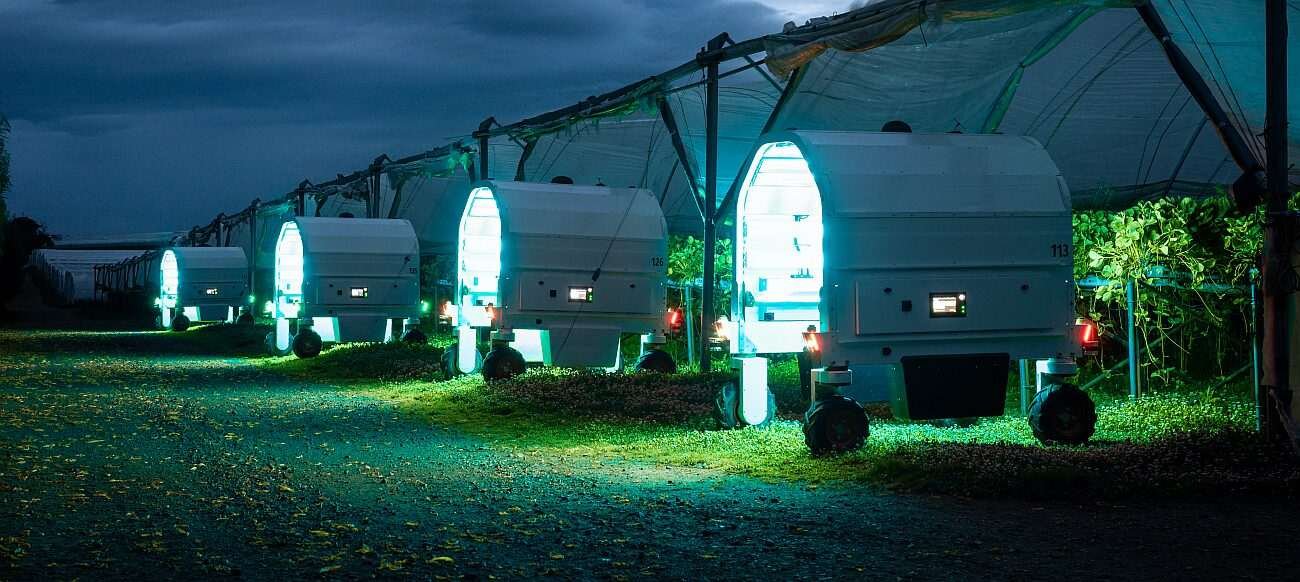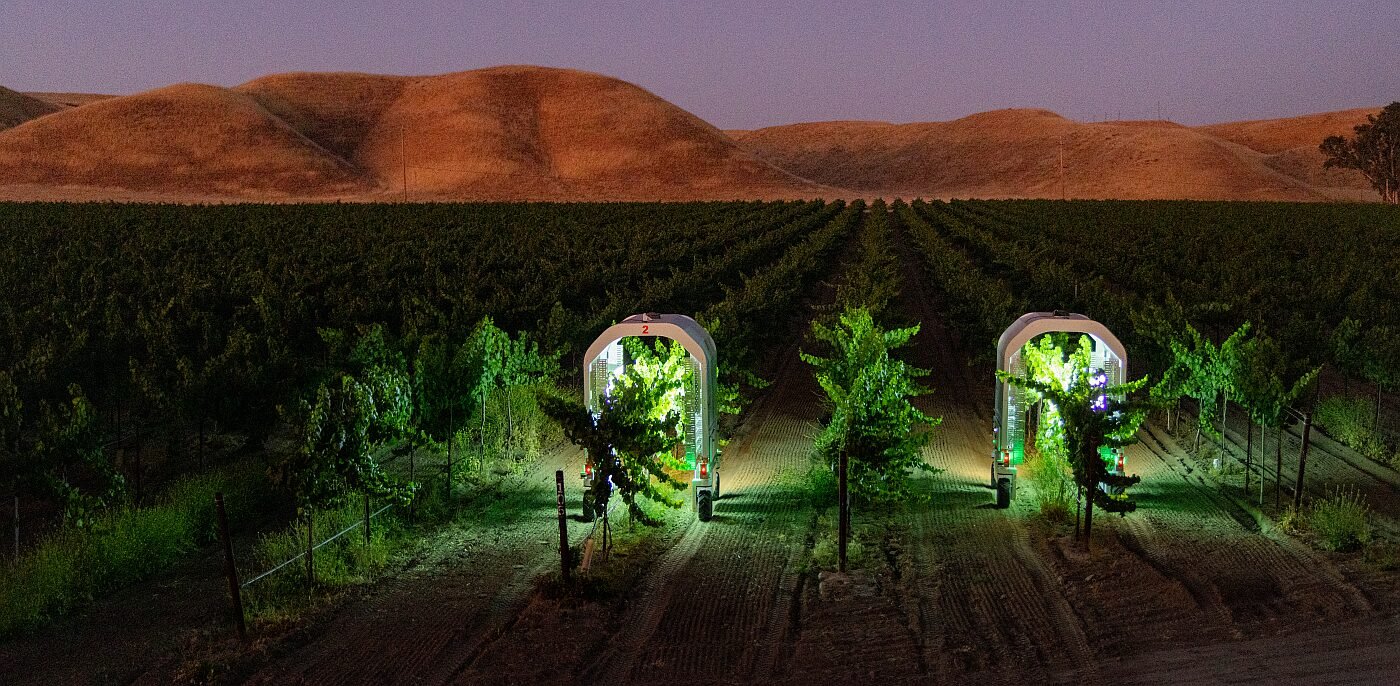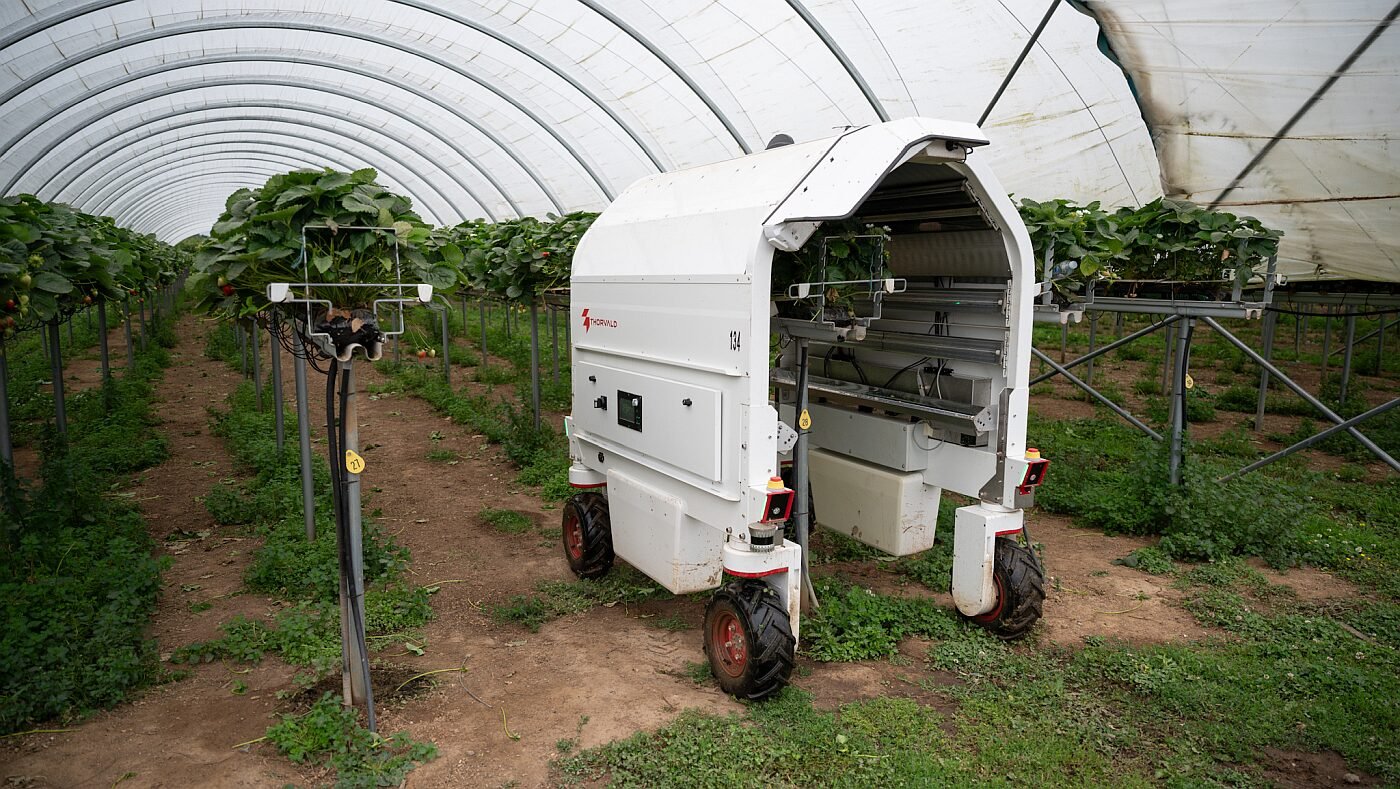Ag robotics specialist Saga Robotics aims to triple its footprint in US vineyards and increase its penetration of the UK tabletop strawberry market to 30% next year after raising new funds to expand its fleet of autonomous ‘bots armed with UV-C light to tackle powdery mildew.
The $11.2 million raise—backed by Praesidium Agri-FoodTech, Aker Capital, Nysnø Climate Investments, Blystad, Hatteland, Melesio, Sanden, and MP Pensjon—will enable Saga to “transition from initial market traction to large-scale commercial adoption,” says the firm.
Founded in 2016 by Dr. Pål Johan From and Lars Grimstad, Saga Robotics’ Thorvald platform now supports 13 leading strawberry growers in the UK and 1,300+ acres of vineyards in California, where powdery mildew is a growing problem.
“We’ve proven Thorvald works; now we’re scaling it,” said From, who recently relocated to California to lead Saga’s US operations. “This raise gives us the runway to accelerate adoption, improve efficiency in agriculture, and reduce chemical use across two of the world’s most chemically dependent specialty crop markets.”
“The Thorvald robot has moved from a prototype to a fully commercially deployed autonomous solution, already servicing thousands of acres in 2025. We’re investing in Saga Robotics because they have the right team, the right tech, proven technology, and a clear path to scale in high-value, underserved agricultural sectors.” Alice Laurora, VP, Praesidium Agri-FoodTech

Ag robotics: No one size fits all
Like many players in the space, Saga operates a Robots as a Service (RaaS) model, whereby growers pay a fee per acre to treat their crops, although some wine growers in California have bought the ‘bots outright now that Thorvald qualifies for California’s CORE incentive program, which offers substantial grants for robot sales.
Given existing fungicides to tackle powdery mildew are becoming less effective, growers typically see a return on their investment through higher yields (as UV-C is more effective) as well as reduced labor costs, From told AgFunderNews.
The latest machines are also kitted out with cameras enabling Thorvald to collect data enabling growers to predict yields and detect disease, generating further savings.
While other players using UV-C for crop protection such as TRIC Robotics have developed larger machines designed for spanning multiple rows of strawberries in open fields, Thorvald is focusing on tabletop strawberries in polytunnels and California’s vineyards, which require smaller machines with significant precision, he said.
“I don’t really see TRIC as a direct competitor. They have a machine that is not built for the markets that we operate in, and we have a machine that will be less ideal in their market as well. And I think that’s the way this market is going; it’s not one solution for all markets because they’re so different. And [fellow UV-C expert] CleanLight is mainly focused on glasshouses.”
While new players are beginning to enter the UV-C space for crop treatments, it will likely take 3-4 years of trials before they are able to scale, predicted From.
“It looks really easy, right? You just stick some lamps on a machine and go… but it’s not.
“I think now enough people have tried it and failed, to show that it’s not just about determining the right dose and frequency, which differs according to the variety, climate, geography. With some machines we see, we could have told them it won’t work from the outset, right? The autonomy needs to be ridiculously precise as you’re very close to the plants, and that’s why no one else has yet managed to do this in polytunnels, for example.”

Funding: ‘It’s the toughest market we’ve raised in’
As for funding, said From, “It’s a terrible market in general, and even worse for startups and scale ups, and worse again for agtech. So I think it’s without a doubt, the toughest market we raised in, but we’ve had pretty good progress over the last years and we’ve established ourselves as the leader in the UV business.
“I think the money is out there, but investors are being more selective.”
He added: “Currently we’re treating 20% of the UK tabletop strawberries and next year about 30%, so we’re in a good spot in the UK, where we’re in our fifth commercial season. We have customers that have been with us for four, five, six seasons and are steadily increasing the acreage now they’re confident that it works.
“Typically we might start with 10-20 hectares in season one, and then maybe we do half the farm in season two, and then the entire farm in season three. And now that the word in the industry is out that the performance in general is better than what you obtain with chemicals, I think we can scale up faster.
“It also helps that we’ve worked with the best growers in the UK, and that’s been a very strategic approach. Let’s work with the biggest and the best, with people that other growers look to and have confidence in. If these guys are doing it, then we should probably be doing it as well.
There are also no direct competitors in UV-C treatments for the strawberry tabletop market in the UK, meanwhile, he claimed. “Our competition is chemicals. I don’t really see there being any competition in the next couple of years, to be honest. Because once we get to 50-60% of the market [which is dominated by large players], the [remaining] farms just become too small and it’s a different game.”
When it comes to the ROI for growers, he said, “In UK strawberries, there’s a slight willingness to pay for sustainability, whereas in wine in California, we don’t see much of that in the current market.
“But what we see in the UK is that we create a lot more value than just replacing chemicals. First of all, we don’t have problems with resistance, so they have better control of powdery mildew, less loss and substantially higher yields. So for some of our customers, what they gain in one year of yield increases will pay for our services for the next five to 10 years. It also saves them quite a bit on the labor side.”

Yield prediction
Moving forward, Saga is now adding value to the battery-powered Thorvald platform with additional offerings, from adding beneficials (insects or mites that are introduced to control pest populations biologically) to data collection for disease detection and yield prediction, to tools to cut runners.
For yield prediction, which has just started generating commercial revenue for Saga this year, said From, “We typically collect data such as how many clusters [of grapes] do you have? What’s the size of the clusters? What’s the size of the berries? And then we can use that to predict the yield. In strawberries, you can simply count the flowers, which will give you an early indication of what your yield will look like.
“We can also recognize outbreaks of diseases and pests.”
Where next for ag robotics?
Stepping back to look at the ag robotics field more generally, he said, “I think we’ve definitely started in the right place with specialty, high value crops, but I think this industry will grow very quickly. I think the number of autonomous robots out in California, for example, will be quite massive in just a few years.
“But there are some tasks where it isn’t viable yet, because there isn’t the dexterity, or it’s just not cost effective. For example we had a pretty advanced strawberry harvester four years ago, which we decided not to pursue because we couldn’t see how it would get to commercial [viability].
“Competing with human dexterity is really tough. But it’s going to happen.”
Further reading:
4AG Robotics raises $29m Series B to expand autonomous mushroom harvesting tech
Armed with fresh funds, TRIC Robotics plans aggressive fleet expansion across CA’s strawberry fields
The post Saga Robotics raises $11.2m to expand fleet of ‘bots blasting powdery mildew with UV-C light appeared first on AgFunderNews.














